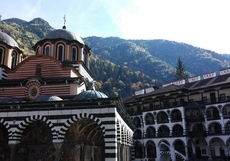The Rila Lakes are no less than 160 although their exact number isn’t known. Some of them are permanent while others are temporary – they only appear during the summer when snow melts. The group that includes the most high-altitude basins is called The Seven Rila Lakes. They are glacial and are situated in one of Rila’s biggest cirques. Seven astonishing places with enchantingly beautiful views, which are full of pureness, freshness and magical energy. Not accidentally, they are the spot that holds the annual gatherings of the White Brotherhood, as the followers of Petar Danov’s occult teachings are known as. Here, people from all over the world, dressed in white, carry out their mysterious rites before the sunrise, performing ritual dances to the sound of violins and guitars.
The Seven Rila Lakes are situated terrace-like, with the highest one being Salzata (The Tear) followed by Okoto (The Eye), Babreka (The Kidney), Bliznaka (The Twin), Trilistnika (The Trefoil), Ribnoto ezero (The Fish Lake) and Dolnoto ezero (The Lower Lake). Its waters flow from one lake to another, forming the beginning of the Dzherman River. The Tear is located at 2535 metres of altitude; it is small at only 7 decares in size and it’s just 4.5 metres deep. At 37.5 metres, The Eye is Bulgaria’s deepest tarn. It has an area of 68 decares and owes its name to its peculiar oval shape. The Kidney Lake, on its part, is named after its kidney-like shape; it’s 28 metres deep and has an area of 85 decares. The Twin Lake gets narrower in the middle and in dry weather becomes almost separated in two smaller lakes which is why it bears this name. It has an area of 91 decares and is 27 metres deep. The Trefoil Lake has an irregular shape and brooks spilled over its shores. At 2.5 metres, the Fish Lake is the shallowest. Its shores are covered in grass and its bottom is muddy and overgrown with greenery. Last is the Lower Lake. It gathers the water from the rest of the lakes. The Dzherman River is “born” in it.
Among the other natural sights in the region are the Urdini Lakes (Urdini ezera) and the Skakavishki Waterfall (Skakavishki vodopad). A natural phenomenon, the endorheic lake of Panichishte is the lowest situated endorheic lake in Rila. It’s up to 4 metres deep and has an area of 12 decares.
Panichishte is also the name of a village situated in Rila Mountain’s northwestern part. It is located at 1300 – 1600 metres of altitude and borders with the Rila National Park. It offers good conditions for skiing – there are ski lifts and runs available. The region is also good for summer tourism with its abundance of hiking trails.
10 kilometres away from Panichishte is the town of Sapareva Banya, famous for its hot mineral springs. Here is Europe’s hottest geyser-fountain with a temperature of 103 degrees Celsius. The mineral water spurts naturally, reaching 18 metres of height.
Nature has generously endowed the town with healing geothermal waters. The water of the warm mineral springs here is Bulgaria’s richest in hydrogen sulfide.
The region of the town has been a centre of life since ancient times. This is evidenced by the archaeological finds in the locality of Kremenik (dated at 4th century B.C.) as well as by a number of discoveries dating from the Early Neolith, The Bronze and the Iron Ages and up to the Late Middle Ages. The hot mineral springs predetermined the fate of the settlement during the time of the Roman Empire – the remains of Roman baths and fortified walls have survived to this day.
And so, unique nature and rich historical heritage blend together at the foot of the Lakes.
